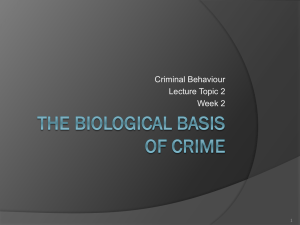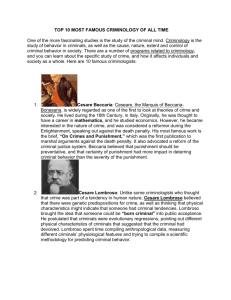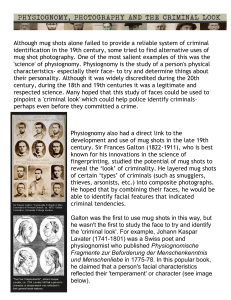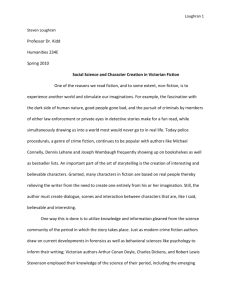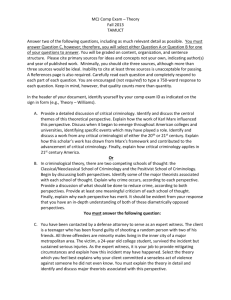Cesare Lombroso and the origins of criminology: Rethinking
advertisement
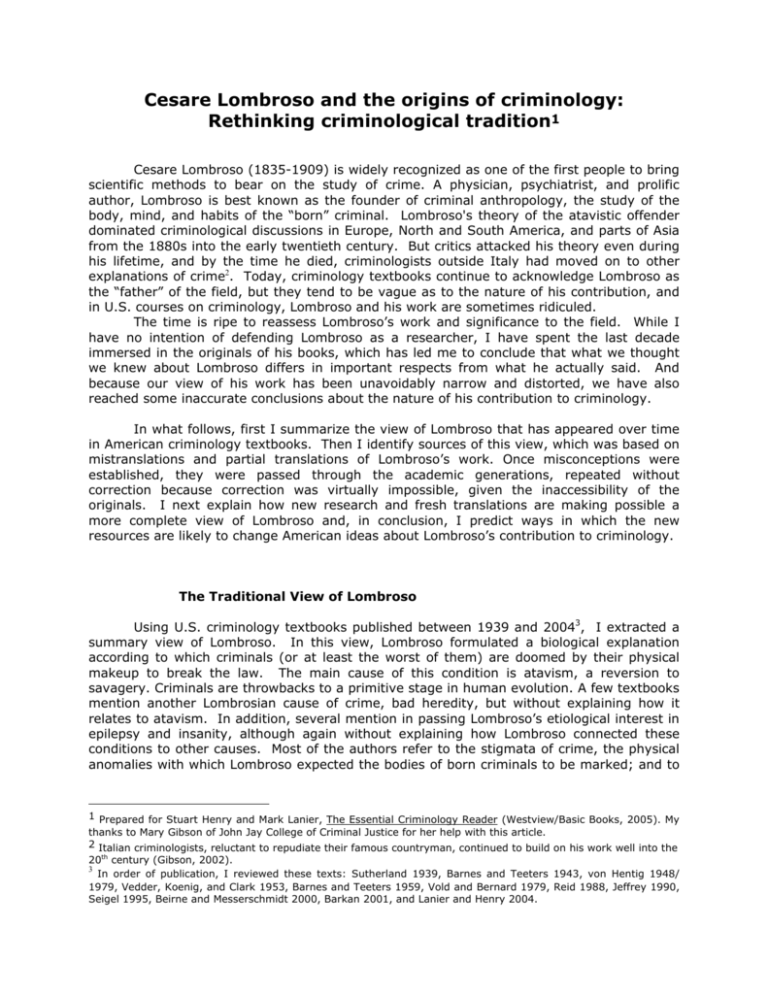
Cesare Lombroso and the origins of criminology: Rethinking criminological tradition1 Cesare Lombroso (1835-1909) is widely recognized as one of the first people to bring scientific methods to bear on the study of crime. A physician, psychiatrist, and prolific author, Lombroso is best known as the founder of criminal anthropology, the study of the body, mind, and habits of the “born” criminal. Lombroso's theory of the atavistic offender dominated criminological discussions in Europe, North and South America, and parts of Asia from the 1880s into the early twentieth century. But critics attacked his theory even during his lifetime, and by the time he died, criminologists outside Italy had moved on to other explanations of crime2. Today, criminology textbooks continue to acknowledge Lombroso as the “father” of the field, but they tend to be vague as to the nature of his contribution, and in U.S. courses on criminology, Lombroso and his work are sometimes ridiculed. The time is ripe to reassess Lombroso’s work and significance to the field. While I have no intention of defending Lombroso as a researcher, I have spent the last decade immersed in the originals of his books, which has led me to conclude that what we thought we knew about Lombroso differs in important respects from what he actually said. And because our view of his work has been unavoidably narrow and distorted, we have also reached some inaccurate conclusions about the nature of his contribution to criminology. In what follows, first I summarize the view of Lombroso that has appeared over time in American criminology textbooks. Then I identify sources of this view, which was based on mistranslations and partial translations of Lombroso’s work. Once misconceptions were established, they were passed through the academic generations, repeated without correction because correction was virtually impossible, given the inaccessibility of the originals. I next explain how new research and fresh translations are making possible a more complete view of Lombroso and, in conclusion, I predict ways in which the new resources are likely to change American ideas about Lombroso’s contribution to criminology. The Traditional View of Lombroso Using U.S. criminology textbooks published between 1939 and 20043, I extracted a summary view of Lombroso. In this view, Lombroso formulated a biological explanation according to which criminals (or at least the worst of them) are doomed by their physical makeup to break the law. The main cause of this condition is atavism, a reversion to savagery. Criminals are throwbacks to a primitive stage in human evolution. A few textbooks mention another Lombrosian cause of crime, bad heredity, but without explaining how it relates to atavism. In addition, several mention in passing Lombroso’s etiological interest in epilepsy and insanity, although again without explaining how Lombroso connected these conditions to other causes. Most of the authors refer to the stigmata of crime, the physical anomalies with which Lombroso expected the bodies of born criminals to be marked; and to 1 Prepared for Stuart Henry and Mark Lanier, The Essential Criminology Reader (Westview/Basic Books, 2005). My thanks to Mary Gibson of John Jay College of Criminal Justice for her help with this article. 2 Italian criminologists, reluctant to repudiate their famous countryman, continued to build on his work well into the 20th century (Gibson, 2002). In order of publication, I reviewed these texts: Sutherland 1939, Barnes and Teeters 1943, von Hentig 1948/ 1979, Vedder, Koenig, and Clark 1953, Barnes and Teeters 1959, Vold and Bernard 1979, Reid 1988, Jeffrey 1990, Seigel 1995, Beirne and Messerschmidt 2000, Barkan 2001, and Lanier and Henry 2004. 3 their credit, most of the textbook authors resist going into a lot of detail on the stigmata the silliest and most vulnerable aspect of Lombroso’s work. Several of the recent textbooks, perhaps sensitized by the current interest in women and crime, mention that Lombroso studied female as well as male offenders, although they are not always clear about what he said in this regard. According to one (Barkan 2001), Lombroso emphasized the female offender’s passivity; according to another (Seigel 1995), he emphasized her masculinity. In addition, some of the books refer to problems with Lombroso’s research. Vedder, Koenig, and Clark (1953) claim that Lombroso failed to use control groups, Jeffrey (1990) that he failed to use statistics. Vold and Bernard hold that he used control groups and statistics, while Jeffrey reports a secondhand rumor that Lombroso sometimes used control groups. Only Sutherland, Vold/ Bernard, and Lanier and Henry, among the authors whose work I examined in detail, observe that Lombroso modified his theories over time. The textbooks link Lombroso’s significance to “positivism,” though few explain the nature of that link or positivism’s significance. One text seems to equate positivism with biological theories of crime per se, while another two imply that it has something to do with debates over determinism and free will. Only three of the works (Vold/ Bernard, Beirne and Messerschmidt, and Lanier and Henry) locate the positivist endeavor in the historical perspective of efforts to apply principles of scientific investigation to an entirely new area of study, that of crime. This summary of the traditional view, while it washes out some of the strengths of the better textbook coverage, reveals a deep uncertainty among authors of American criminological textbooks as to the substance of Lombroso’s criminology and its significance. Sources of the Traditional View The traditional view is understandably vague and halting: it was based on inadequate sources. Even though Lombroso’s L’uomo delinquente or Criminal Man is widely acknowledged as a foundational text in the field, it has been available to English-only readers solely through two incomplete editions, both published in 1911. The first is a volume titled Lombroso’s Criminal Man, produced shortly after his death by his daughter and translated by an unidentified party. This edition was reprinted in 1972 by Patterson Smith, but it is now out of print. Most of it seems to have been authored by Gina Lombroso-Ferrero herself, not her father. For example, one passage reads: “It was these anomalies that first drew my father’s attention to the close relationship between the criminal and the savage, and made him suspect that criminal tendencies are of atavistic origin” (Lombroso-Ferrero, 1911/1972: 5). Clearly, these are the daughter’s words, not the father’s. There is no way to tell, from the book itself, how accurately or completely Gina Lombroso-Ferrero presented her father’s ideas. The second English-language source is Crime: Its Causes and Remedies, a translation by Henry P. Horton, now also out of print. In his “Translator’s Note,” Horton writes that he worked from a French edition of 1899, supplementing it with a German edition of 1902. He can only speculate on the relationship of these sources to the Italian originals and has no idea how the textual extract he has translated relates to Lombroso’s L’uomo delinquente as a whole.4 Unless one compares these two English-language volumes with the Italian originals, one cannot possibly determine their relationship to Lombroso’s own thought. Lombroso took L’uomo delinquente through five editions, the first a one-volume study published in 1876, 4 As Horton guessed, Crime: Its Causes and Remedies was based on the third volume of the fifth edition of L’uomo delinquente. the last a 4-volume work published in 1896-97. Are the English-language sources based on the first edition? the fifth? on Gina Lombroso-Ferrero’s ’s vision of a text she wished her father had written? How did Lombroso’s ideas evolve over time? Does our traditional view of Lombroso derive from the first edition, the last, both, or all five? Is it perhaps based, as in the case of Crime: Its Causes and Remedies, on a translation of a translation? Similar issues are raised by Lombroso’s other major criminological work, La donna delinquente, co-authored with Guglielmo Ferrero and published in Italian in 1893. This was translated into English in 1895 as The Female Offender and frequently reprinted thereafter, though it too is now out of print. The translation fails to mention that it covers only two of the original’s four major sections. It also does not acknowledge that it has excised half of the original text, leaving out nearly all the material on “normal” women (the control group) and prostitutes. Nor does it mention that it switches the order of some chapters and bowdlerizes the original by cutting most references to female breasts and genitals and excising discussions of lesbianism and sexual deviance. Not only did the anonymous translator impose Victorian prudery on this book (a real shame, as the study made one of the earliest contributions to the field of sexology); he or she rendered the original into literal but frequently incomprehensible English from which it is difficult to extract criminological concepts. In this case, too, then, it is impossible to test the traditional view of Lombroso against his text. The traditional view may be true or it may be false; one cannot tell. New Resources New resources are beginning to overcome the traditional inadequacy of our Lombroso materials. One consists of new studies in Italian: over the past several decades, there has been an outpouring of books and articles on Lombroso, including studies of his life and work (Bulferetti 1975, Villa 1985), his daughters’ lives (Dolza 1990), his museum (Colombo 2000, Portigliato Barbos 1993), and his work on a particular criminal case (Guarnieri 1993). The new studies include a slightly fictionalized biography (Guarnieri 2000) and an intellectual history of Lombroso and criminal anthropology (Frigessi 2003). The French and Germans, too, have started to reexamine their involvement in criminal anthropology (Mucchielli 1994, Gadebusch Bondio 1995). In English, Gibson’s Born to Crime (2002) provides a study of Lombroso’s impact on Italian criminal justice practices before, during, and after fascism; Horn’s The Criminal Body (2003) offers a history of Lombroso’s idea that bodies themselves can testify to legal and scientific truths; and Cambridge University Press will soon publish Criminals and Their Scientists (Becker and Wetzell 2005), a collection of original essays examining Lombroso’s influence on various fields and in various countries. Results of this international explosion of Lombroso scholarship will eventually filter through to working criminologists and their students, improving knowledge of Lombroso’s socio-cultural circumstances, his sources, and his own research. Another new source of material is fresh translations. Mary Gibson, an Italian historian at John Jay College of Criminal Justice, and I have prepared new Lombroso translations for Duke University Press. The first, which we have retitled Criminal Woman (a more accurate rendering of La donna delinquente than The Female Offender), appeared in 2004; our Criminal Man will follow in 2005. Because one of our primary concerns is to make the texts accessible, and because accessible books must be both readable and affordable, we have condensed so as to give a full view of Lombroso’s originals while omitting repetitions and unnecessary examples. The new Criminal Man will include passages from all five of Lombroso’s own editions so that English-only readers can, for the first time, follow the development of his ideas over the two decades on which he worked on this magnum opus. In addition, we have restored the references to sex and sexuality to Criminal Woman. Our extensive annotations and introductions are designed to clarify difficult passages, locate Lombroso in historical context, and show how his thought related to that of other major European intellectuals of the late nineteenth-century. We reproduce Lombroso’s own notes, enabling readers to identify his specific sources; we also reproduce many of his illustrations, including the bawdy tattoos. These new translations should help correct misconceptions about Lombroso’s work. Let me indicate just a small part of their potential by mentioning ways in which they contradict the traditional view of Lombroso. Revisionist Views Lombroso anticipated one of the most influential criminological ideas of recent decades, the distinction between life-course persistent and adolescence-limited offenders (Moffitt et al. 2001), according to which some criminals continue to break the law for most of their lives while others desist after their teenage years. Lombroso’s born criminal is equivalent to the life-course persistent offender, someone who continues violating the law into old age. Lombroso was not unique in formulating this concept of the lifelong recidivist, which also turns up in the work of several other late 19th-century criminologists; but he was the first to explore it in depth and make it the basis for a galvanizing popular image of the criminal. His typology, ranging from the biologically doomed born criminal through the salvageable criminaloid to idealistic and essentially innocent political criminal, incorporates the idea of criminality as a continuum, a concept closely related to Moffitt’s distinction between the biologically- handicapped lifecourse persistent offender and the more adaptable adolescence-limited offfender. Lombroso also anticipated one of the most controversial theories in recent criminology: that of evolutionary criminology (e.g., Ellis and Walsh 1997), according to which personality structures conducive to crime are holdovers from an evolutionary period when rape and pillage contributed directly to male reproductive fitness. Regardless of one’s opinion of evolutionary criminology, one can see a very similar notion in Lombroso’s idea of the criminal as atavism, a throwback to an earlier evolutionary stage when savage behaviors were more useful and social and personal controls had not yet developed. In this respect, then, Lombroso stole a march upon one of the major strands in current biological explanations of crime. Lombroso further anticipated genetic explanations of crime. Although he died before the concept of genes became familiar, Lombroso’s theory of degeneration, or an inherited tendency to devolve and become socially problematic, broadly resembles today’s genetic theories. These theories argue that heredity interacts with environment to produce individuals with various potentials for offending. This is similar to what Lombroso said when he analyzed the ways in which social, hereditary, and environmental factors interact to produce criminals and crime. Thus although some aspects of Lombroso’s work are indeed outmoded today, others arguably offer examples of prematurity in scientific discovery (Hook 2002). The new translations enable us to determine what Lombroso meant by “positivism.” He called for the collection of “facts”- data about crime and criminals that could be verified and, ideally, quantified – and insisted on inductive reasoning from these facts, even though he often fell short of that goal himself. To follow him through the five editions of Criminal Man is to see him constantly searching for new data, adding cross-national comparisons, refining and elaborating his ideas. He identified fresh data sources, found and invented measuring tools to collect better information, and devised novel methods for displaying his data. Moreover, the new editions show Lombroso struggling to figure out how to apply his positivist principles, as when in studying female criminality, for instance, he tries to construct a control group of normal women. (The first English translation left that part out.) The overall lesson of the new editions is that, notwithstanding his many scientific shortcomings, Lombroso was in fact central in and crucial to the development of the positivist tradition that remains fundamental to scientific criminology. While he had predecessors, he was indeed the “father” of scientific methods in criminology. I would go so far as to suggest that Lombroso was the only figure in the history of criminology who might qualify for having produced one of those seismic scientific reorientations that the historian Thomas Kuhn (1970) labeled paradigm shifts. Before Lombroso, the study of crime fell into the domain of metaphysicians, moralists, and penologists; Lombroso turned it into a biosocial science. In retrospect we can see that Lombroso often worked along major intellectual fault lines, in contested areas where various trends in social thought collided. The tensions in his work - between feminism and antifeminism, liberalism and conservatism, protofascism and socialism, humanism and positivism – are as instructive as his attempted resolutions. In any case, Lombroso had one of the most fertile minds in 19th-century Europe and produced a body of work seldom equaled for its variety, richness, and influence. Subsequently mocked and forgotten, Lombroso is today being rediscovered. We are on the verge of better understandings that will, I think, help us better understand the origins of criminology itself. Nicole Rafter, College of Criminal Justice, Northeastern University References Baima Bollone, Pierluigi 1992 Cesare Lombroso: Ovvero: Il pincipio dell’irresponsabilità. Torino: Societa editrice internazionale. Barkan, Steven E. 2001 Criminology: A Sociological Understanding. Saddle River, NJ: Prentice-Hall. 2d edition. Upper Barnes, Harry Elmer and Negley K. Teeters 1943. New Horizons in Criminology. New York: Prentice-Hall. _____ 1959. Hall. New Horizons in Criminology. 3d edition. Englewood Cliffs, N.J.: Prentice- Becker, Peter and Richard F. Wetzell, eds. 2005 (forthcoming) Criminals and Their Scientists: The History of Criminology in International Perspective. Cambridge: Cambridge University Press. Beirne, Piers and James Messerschmidt 2000 Westview Press. Criminology. 3d edition. Boulder, Colorado: Bulferetti, Luigi 1975 Cesare Lombroso. Torino: Unione tipografico-editrice torinese. Colombo, Giorgio (1975) 2000 La scienza infelice: Il museo di antropologia criminale di Cesare Lombroso. Torino: Bollati Boringhieri. Dolza, Delfina 1990 Essere figlie di Lombroso: Due donne intellectuali tra ‘800 e ‘900. Milan: F. Angeli. Ellis, Lee. and Anthony Walsh 1997 Criminology 35: 229-276. “Gene-Based evolutionary Theories in Criminology.” Frigessi, Delia 2003 Cesare Lombroso. Torino: Einaudi. Gadebusch Bondio, Mariacarla 1995 Die Rezeption der kriminalanthropologischen Theorien von Cesare Lombroso ini Deutschland von 1880-1914. Ed. Rolf Winau and Heinz MullerDeitz. Husum: Matthiesen. Gibson, Mary 2002 Born to crime: Cesare Lombroo and the Origins of Biological Criminology. Westport, CT: Praeger. Guarnieri, Luigi 2000 L’atlante criminale: la vita scriteriata di Cesare Lombroso. Mondatori. Milan: Guarnieri, Patrizia 1993 A Case of Child Murder. Cambridge: Polity Press. Hook, Ernest B., ed. 2002. Prematurity in Scientific Discovery: On Resistance and Neglect. Berkeley: University of California Press. Horn, David 2003 The Criminal Body: Lombroso and the Anatomy of Deviance. New York: Routledge. Jeffrey, C. Ray 1990 Criminology: An Interdisciplinary Approach. Prentice Hall. Englewood Cliffs, N.J.: Kuhn, Thomas S. 1970 The Structure of Scientific Revolutions, 2d ed. enlarged. Chicago: University of Chicago Press. Mark M. Lanier and Stuart Henry 2004 Essential Criminology. Westview Press. 2d ed. Boulder, CO: Lombroso, Cesare 1911/ 1918 Crime: Its Causes and Remedies. Horton. Boston: Little, Brown, and Company. Translated by Henry P. Lombroso, Cesare Forthcoming, 2005 Criminal Man. A new translation with an introduction and annotations by Mary Gibson and Nicole Hahn Rafter. Durham, N.C.: Duke University Press. Lombroso, Cesare and Guglielmo Ferrero 2004 Criminal Woman, the Prostitute, and the Normal Woman. A new translation with an introduction and annotations by Nicole Hahn Rafter and Mary Gibson. Durham, N.C.: Duke University Press. Lombroso, Cesare and William Ferrero 1895 The Female Offender. New York: D. Appleton. Lombroso-Ferrero, Gina 1911/ 1972 Criminal Man According to the Classification of Cesare Lombroso. Montclair, NJ: Patterson Smith. Moffitt, Terrie E., Avshalom Caspi, Michael Rutter, and Phil A. Silva 2001 Sex Differences in Antisocial Behaviour. Cambridge: Cambridge University Press. Mucchielli, Laurent, ed. L’Harmattan. 1994 Histoire de la criminologie française. Paris: Editions Portigliatti Barbos, Mario 1993 “Cesare Lombroso e il museo di antropologia criminale.” Pp. 1141-60 in Storia illustrata di Torino, ed. Valerio Castronovo. Milan: Elio Sellino. Reid, Sue Titus 1988 Crime and Criminology. 5th ed. New York: Holt, Rinehart and Winston. Siegel, Larry J. Company 1995 Criminology. Sutherland, Edwin H. Company. 5th edition. St. Paul, Minnesota: West Publishing 1939 Principles of Criminology. 4th ed. Chicago: J. B. Lippincott Vedder, Clyde B., Samuel Koenig, and Robert E. Clark 1953 Criminology: A Book of Readings. New York: The Dryden Press. Villa, Renzo 1985 Il deviante e i suoi segni: Lombroso e la nascita dell’ antropologia criminale. Milan: F. Angeli. Vold, George with Thomas J. Bernard 1979 Theoretical Criminology. Oxford University Press. 2d ed. New York: von Hentig, Hans 1948/1979 The Criminal & His Victim. New York: Schocken Books.
